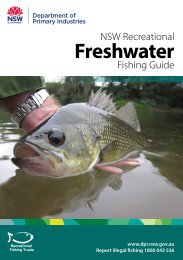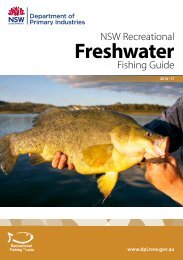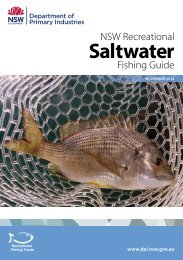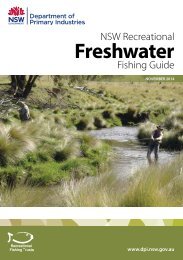Go-Fishing-Blowering-Dam
You also want an ePaper? Increase the reach of your titles
YUMPU automatically turns print PDFs into web optimized ePapers that Google loves.
NSW Guide
Go Freshwater
Featured Location :
Stocked impoundment & home to
MEGA SIZED
MURRAY COD !
Message from the Minister
Overview
Blowering Dam is situated in the lower reaches
of the Snowy Mountains and Kosciusko National
Park between the townships of Talbingo and
Tumut.
The location in which the dam is situated could
be the reason as to why it is such a unique
fishery. It sits at a low enough altitude to home
a strong population of native species, although
it still sits high enough to receive the positives
of cooler water temps and sparkling snow melt
waters that are associated with the alpine trout
dams. With such good numbers of natives along
with the crystal clear snow melt waters that
allow visibility of up to five metres, this dam is capable
of producing outstanding sight fishing opportunities for
Murray cod and other natives.
Blowering Dam is also known by the locals as “Lake
Disappointment” due to the hours it can take to land a fish.
In saying this, it’s a highly popular location because the
results are well worth the effort. This dam is home to some
of the largest Murray cod in the country and keen anglers
travel long distances to try their luck on these trophy fish.
The fish are extremely healthy with majority of the resident
cod being very fat for their length due to the abundance of
food in the dam.
DPI research indicates that the dam’s cod fishery is heavily
reliant on stocked fish recruitment, with very little natural
fish recruitment.
Contents
Overview 3
Blowering Dam Map 5
Key Target Species 6
Fact box: Winter Murray Cod
on big soft plastics 9
Fact box: Correct handling 10
Handy knots 11
Throwing a line at a new spot always makes for a great
fishing adventure. Whether you’re just starting out or an
expert fisher, NSW boasts some of the best locations to
fish in the world. In addition to being one of the state’s
favourite activities, recreational fishing is a massive
contributor to our economy. It’s a $3.4 billion industry
and generates 14,000 full-time jobs across the state.
The NSW Government knows how important recreational
fishing is and has developed a range of programs to
enhance angler access and opportunities. This series of
guides to popular fishing locations is a great example
of the proactive approach by the NSW Government to
promote recreational fishing. We’re fortunate to live in
NSW where there are so many great places to fish. I hope
these DPI guides help you have a safe and productive
fishing experience around our great state. Tight lines!
Sydney
The Hon Niall Blair MLC
Minister for Primary Industries,
Minister for Regional Water
Minister for Trade and Industry
continued on page 4
Cover image: Rhys Creed. Image of Minister Blair courtesy of Al McGlashan. Image of Golden Perch: NSW DPI Image Library - Gunther Schmida. All other images: Rhys Creed. Fish illustrations: Pat Tully
14108 08/2018
This fishing location guide is produced by the NSW Department of Primary Industries (NSW DPI) LMB 3020 Nowra NSW 2541, for and on the behalf of the state of New South Wales. This guide is
produced using funds from the Recreational Fishing Trust as part of our commitment to providing recreational fishers with comprehensive, user-friendly information.
© State of NSW through NSW Department of Industry, Skills and Regional Development 2018
Disclaimers
This publication may provide assistance or information but NSW DPI and its employees do not guarantee the publication is without flaw or is wholly appropriate for any particular purpose and
therefore disclaims all liability for any error, loss or other consequence which may arise from relying on any information in this publication. This publication is a guide only, it does not replace
the Fisheries Management Act 1994 or other acts and statutory rules applying to or affecting recreational fishing. It is a summary of laws and regulations at the time of publication and cannot
be used as a defence in a court of law.
Recreational fishing regulations may change during the lifetime of this publication. It is the responsibility of
fishers to ensure they are acting within the law at all times. Check regulations with your local NSW DPI fisheries
office or www.dpi.nsw.gov.au/fisheries.
No material matter in this publication may be reproduced, stored in a retrieval system, or transmitted in any form
by electronic or mechanical means, photocopying or recording without the written permission of NSW DPI.
Blowering
Dam
2
GO FISHING – BLOWERING DAM
GO FISHING – BLOWERING DAM
3
continued from page 3
This mirrors results at Copeton Dam, in northern
NSW, which was also found to have very low natural
recruitment levels and a high dependence on fish
stocking to sustain the fishery.
As a result, Blowering Dam, like Copeton, has been
opened to fishing all year-round, as the annual closure
between September-November isn’t needed where the
population is based almost
entirely on stocking.
As well as natives,
Blowering supports
good trout fishing
at times (the
surrounding area
boasts fantastic
trout fishing, with
the Tumut River
being particularly
productive) as well as
redfin and carp.
The scenery is another
reason to visit this magical lake. It sits in a large valley
surrounded by mountain terrain, pine and gum forests
with flat grassy camp spots and a perfect climate.
There are five good quality reserves along the Snowy
Mountains Highway side of the lake. If you prefer to get
away from the crowds, you can take a more adventurous
route and come in from the western side via Batlow.
NOTE: This fishing map is only to
be used as a general reference
overview.
Not for navigation.
See www.rms.nsw.gov.au
for info on boating
safety and regulations.
Caution: The high altitude and
open nature of this location can
lead to sudden changes in weather
conditions. Telephone 13 12 56 for
information.
Caution: Boating on inland waters
demands special care. Information
on boating in these areas can be found
at www.rms.nsw.gov.au.
Warning: Beware of submerged
rocks, trees and shallow areas,
particularly at lower levels.
NSW DPI Fisheries
Report illegal or suspect fishing activities
to the local Fisheries Office at
64 Fitzroy St Tumut 2720.
Contact phone is 02 6941 1404.
You can also call the Fishers Watch Phoneline
on 1800 043 536 or online at
www.dpi.nsw.gov.au/fisheries/compliance
MC
GP
T
C
Murray Cod
Golden Perch
Trolling
Casting
Fishing
Camping
Toilet
Launching ramp
Warning: Overhead
power cables
Tumut 10 km
DAM WALL
T-MC, GP
C-GP
C-MC, GP
C-GP
Caution: Shallow
area at lower
water levels.
Cannon
C-GP Bay
C-GP
C-GP
T&C-MC
T&C-MC
T-MC
T&C-MC, GP
C-GP
C-MC, GP
T&C-MC, GP
C-MC, GP Caution: Gravel
Feed
Log Bridge Reserve
rise at lower water
Bay
levels. T-MC, GP
Batlow 10 km
Stat
Bay
Browns
Bay
Warning: Keep clear of wall, spillway
and associated structures.
Caution: Shallow
area at lower
water levels.
Sticky
Bay
C-MC, GP
Humes Crossing
Yatching Point
The Pines
Sydney 420 km
Blowering
Dam Map
Canberra 65 km
Caution:
Shallow water
Special mark aqua
bouy
C-MC,GP
Yellowin
Bay
T-MC
Chucks
Bay
C-MC,GP
C-MC,GP
Yolde Reserve
Yellow light beacon
West cardinal conical
buoy
C-MC,GP
T&C-MC,GP
4
4 GO FISHING – BLOWERING DAM
Productive trolling
areas
0 1 km 2 km 4 km
No boating and fishing
zone between here and
Jounama Wall
JOUNAMA
PONDAGE WALL
Jounama
Pondage
Talbingo
Key target species
Murray cod
PEAK SEASON – Blowering is
open to fishing for Murray cod
all year with spring, autumn and
winter being prime times.
TECHNIQUE – Bait fishing with
large yabbies and grubs from the
bank, especially at night; trolling
hard-bodied deep diving lures
in the 90–150 mm size range around rocky banks and sunken logs; casting large
spinnerbaits and soft plastics (focus on steep rocky banks during summer and
shallow grassy areas in the cooler months).
TACKLE – Heavy 6–10 kg baitcaster outfits loaded with 30–50 lb braided mainline
with a rod length of 30–50 lb fluorocarbon leader. A large knotless landing net,
gloves and heavy duty pliers are important pieces of equipment to have onboard.
HOT SPOTS – Steep rocky banks, back of bays, large snags and logs, shallow banks
(during winter).
BAG & SIZE LIMITS – Two per angler per day, slot limit of 55–75cm. Possession limit: 4.
Rocky banks and snags are excellent habitat for native
sportfish like Murray cod and golden perch because
they offer food and shelter. A rocky bank or snag is
always worth a few casts! Fish numbers in Blowering
are enhanced by regular stocking of natives and
trout. More than 2.5 million native fish and trout
fry/fingerlings have been stocked by DPI and
angling groups into the lake over the past 15 years.
Golden Perch
PEAK SEASON – September to
December.
TECHNIQUE – Casting small lipless
crankbaits, soft plastics and hardbodied
lures at standing trees, flooded
banks and rocky points; trolling rocky
points at a depth contour between
4–7 m with small hard-bodied lures
measuring between 50-90mm.
TACKLE – 2–4 kg spin outfits, 2.1m graphite rod, 2500 size spin reel, 8-10lb braided
mainline with a rod length of 8-10lb fluorocarbon leader. Small soft plastics with 1/6-1/4
oz jighead and size 1 or 2 hook work well on golden perch.
HOT SPOTS – Rocky points, twiggy trees, dirty water, snags.
BAG & SIZE LIMITS – 5 per angler per day, 30 cm legal length. Possession limit: 10.
6 GO FISHING – BLOWERING DAM
GO FISHING – BLOWERING DAM
7
Key target species – cont.
Up until fairly recently, Blowering was
best known as being a trout fishery. DPI
stocks both rainbow and brown trout
into the dam’s cool, clean waters with the
cooler months the best time to target
these freshwater sportfish.
Trolling or casting small diving hardbodies
or “Tassie Devil” style lures is an
effective technique when targeting trout.
They also respond to baits such as worms,
mudeyes and artificial “Powerbait” style
products.
Trout have a minimum size limit of 25 cm
in Blowering with a daily bag of five fish
and a possession limit of 10.
Introduced redfin, which are a Class 1
noxious pest in NSW, are also present in
Blowering, sometimes in large numbers.
Redfin, aka English perch, are native to
northern Europe and were introduced to
Australia in the 1860s. It is illegal to be in
possession of live redfin in NSW. It is also
illegal to use live or dead redfin for bait.
There are no bag or size limits on redfin in
NSW. Many anglers enjoy catching redfin
as they are good sport and a popular
table fish. Redfin can be targeted on
similar lures to those used for trout.
European carp are also available in
Blowering. This introduced species
originates from central Asia and can grow
to impressive sizes. Carp will sometimes
take a lure meant for a cod or yellowbelly
but are most commonly caught on baits
including worms, shrimps, corn kernels
and bread. Carp have spread throughout
the Murray-Darling Basin and can cause
serious degradation to natural aquatic
systems. As with redfin, there are no bag
and size restrictions on carp. Anglers are
encouraged to humanely dispatch and
utilise any carp caught in Blowering.
FACT BOX
NEW TECHNIQUE: WINTER
MURRAY COD ON BIG SOFT
PLASTICS
In the past few years the technique of casting big soft plastics for Murray cod has really
come to life in Blowering Dam. During winter the trout in the dam become active and are
actively hunted by Murray cod across the shallow grassy flats.
Large 150–200 mm soft plastics ideally represent the trout and are perfect options for
large cod. The best locations include shallow grassy banks and areas where you can see
rising trout. Hold your boat well away from the bank in 5–7 m of water and cast towards
the bank. Let the lure hit the bottom, lift and then slow roll back to the boat.
June, July and August are the best months for this technique. Make sure you have a
heavy rod to help with casting the large lures and to land the big fish. Look for big fish
profile plastics and rig them on a 3/4 oz jighead, 7/0 hook and a stinger hook.
8 GO FISHING – BLOWERING DAM
GO FISHING – BLOWERING DAM
9
FACT BOX
HANDY KNOTS
CORRECT HANDLING
The trophy-sized Murray cod that inhabit Blowering Dam are a once-in-a-lifetime capture
for most anglers. Looking after these great native sportfish is paramount to ensure their
survival.
When landing a Murray cod use a large knotless net. Once the fish is in the net, leave it in
the water until you have your brag mat, camera and other equipment ready. Never lay the
fish on a hot deck, always wet the brag mat before laying the fish down to measure.
When handling large Murray cod it is recommended to use a glove rather than lip grips
as this will allow for a better grip on the fish and minimise any damage to the fish’s jaw.
Always support the weight of the fish with your second hand. When lifting, always lift the
fish parallel; never put any pressure on the vertebrae behind the fish’s head.
If your camera is immediately available, take a few quick
pictures and hold the fish in the water until it is ready
to swim away. Take the photos with the fish in the
water or just lift the fish out quickly and
then place it back in the water.
UNI KNOT – This is an excellent knot for connecting hooks and swivels to the end
of fishing lines. A very dependable knot. Use more wraps with lighter line, less with
heavier line.
1. Thread line through eye. 2. Make this configuration. 3. Begin wrapping loop C
with tag A.
4. Continue wrapping four
to six times.
5. Moisten the line and
form a knot by pulling
tag A against loop C.
6. As you continue to
pull on the tag all of
the spirals in the tag
are transferred to the
loop D.
7. This forms a slipping
knot and loop.
8. The loop C disappears
as the knot slides down
on to the eye.
DOUBLE UNI KNOT – This is a useful knot for joining two lines.
1. Overlap the lines to be joined
then encircle one line with the
tag of the other.
2. Wrap the double strand inside
the formed loop.
3. Make four wraps in all.
4. Do the same with the other line
so the knot in each line is tied
around the other.
5. Moisten the line and tighten
each knot in turn.
6. Draw the knots together, tighten
once more, then trim the tags.
10 GO FISHING – BLOWERING DAM GO FISHING – BLOWERING DAM 11








